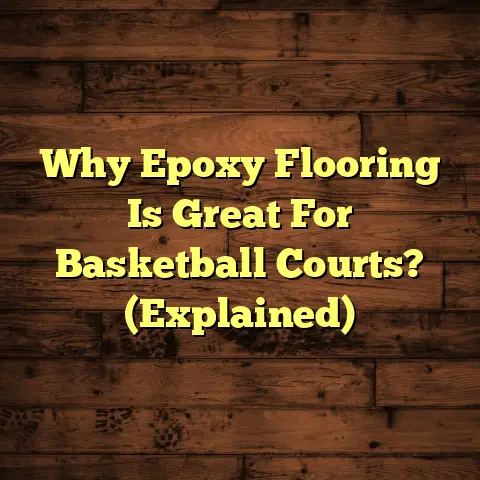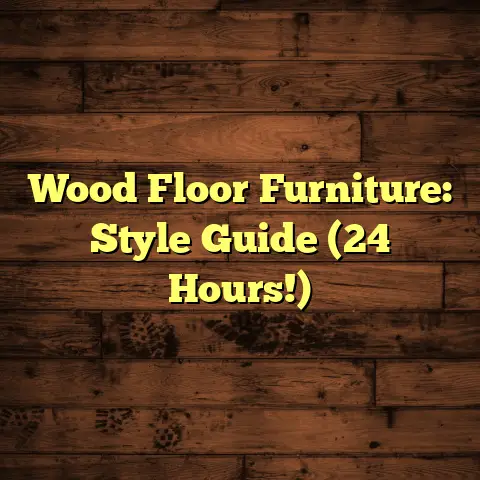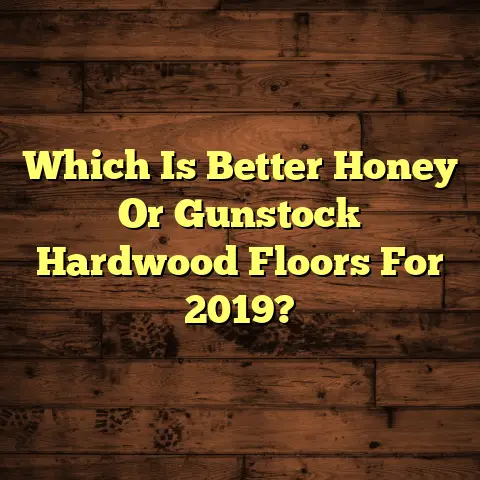Wood Floor Alternatives That Won’t Break The Bank? (3 Best Bets!)
Let’s be honest, who doesn’t love the look of wood floors? I mean, they’re classic, right? They bring this warmth and charm to a home that’s hard to beat.
Wood floors add a touch of elegance and can really boost your home’s value. Plus, they go with just about any style, from modern farmhouse to traditional chic.
But here’s the thing: real hardwood can be seriously pricey. And let’s not forget the maintenance – all that sanding, staining, and worrying about scratches and water damage.
That’s why I want to share some fantastic, budget-friendly alternatives that give you the look of wood without emptying your wallet. Ready to dive in?
The Importance of Choosing the Right Flooring
Choosing the right flooring is a big deal. It’s not just about what looks good; it’s about how it holds up, how easy it is to clean, and how it makes you feel when you walk into a room.
Think about it: flooring sets the tone for your entire home. A bright, airy floor can make a small space feel bigger, while a rich, dark floor can add a sense of luxury and warmth.
And don’t forget resale value! The right flooring can definitely make your home more attractive to potential buyers. But with so many options out there, how do you choose?
That’s where cost-effective alternatives come in. More and more homeowners are realizing that you don’t have to spend a fortune to get beautiful, durable floors.
These alternatives offer a great balance of aesthetics, performance, and affordability, making them a smart choice for budget-conscious homeowners.
Introduction to Affordable Wood Floor Alternatives
The flooring market is booming with innovative materials that mimic the look of wood. It’s incredible what manufacturers can do these days! You can find alternatives that look and even feel like real wood.
And the best part? Many of these options are more environmentally friendly than traditional hardwood. They often use recycled materials and require less energy to produce.
Plus, they’re usually easier to maintain and more resistant to scratches, dents, and water damage. So, you get the look you love with less hassle.
Now, let’s get to the good stuff. I’m going to share my top three picks for affordable wood floor alternatives. These are the ones I recommend to my clients who want style and durability without breaking the bank.
Ready to see what they are?
Best Alternative #1 – Luxury Vinyl Plank (LVP)
Okay, first up is Luxury Vinyl Plank, or LVP as we call it in the trade. Now, don’t let the word “vinyl” fool you. This isn’t your grandma’s linoleum!
LVP is a completely different animal. It’s made up of multiple layers, including a waterproof core, a high-definition photographic layer that creates the wood look, and a durable wear layer that protects against scratches and dents.
What I love about LVP is how incredibly realistic it looks. You can find LVP that mimics just about any wood species, from oak and maple to hickory and walnut. And the textures are amazing!
Some LVP even has embossed textures that make it feel like real wood under your feet. It’s seriously impressive.
But the real beauty of LVP is its practicality. It’s 100% waterproof, making it perfect for kitchens, bathrooms, and basements – places where real wood would be a disaster.
It’s also super easy to install. Most LVP comes in click-lock planks that simply snap together, making it a great DIY project. And cleanup is a breeze – just sweep or mop!
Now, let’s talk about price. On average, LVP costs between $2 and $7 per square foot, installed. Compared to hardwood, which can easily run $8 to $15 per square foot, that’s a significant savings.
Here’s a quick comparison table:
| Feature | Luxury Vinyl Plank (LVP) | Hardwood Flooring |
|---|---|---|
| Cost (Installed) | $2 – $7 per sq ft | $8 – $15 per sq ft |
| Water Resistance | 100% Waterproof | Not Waterproof |
| Installation | Easy Click-Lock | Professional Recommended |
| Maintenance | Low | High |
| Durability | Excellent | Good |
I had a client, Sarah, who wanted to update her kitchen but was worried about water damage. She has two young kids and a dog, so spills are a daily occurrence.
We installed LVP that looked like reclaimed barn wood, and she absolutely loves it! It completely transformed her kitchen, and she doesn’t have to worry about every little spill.
Another client, Tom, installed LVP in his basement. He wanted a warm, inviting space for his family to hang out, but he was concerned about moisture. LVP was the perfect solution!
As for design trends, LVP is incredibly versatile. You can find it in a wide range of colors, styles, and plank sizes. Wide plank LVP is especially popular right now, as it creates a more modern and spacious look.
Gray tones are also trending, as they complement a variety of décor styles. And don’t be afraid to mix and match LVP with other flooring types, like tile or carpet, to create a unique and personalized look.
Best Alternative #2 – Laminate Flooring
Next up is laminate flooring. Now, laminate has been around for a while, but it’s come a long way in recent years. The quality and realism of laminate flooring have improved dramatically.
Laminate is made up of several layers, including a high-density fiberboard (HDF) core, a photographic layer that creates the wood look, and a tough, transparent wear layer that protects against scratches, dents, and fading.
The key to a good-looking laminate floor is the quality of the photographic layer. The better the image, the more realistic the floor will look. And these days, manufacturers are using advanced printing technology to create incredibly detailed and realistic wood grain patterns.
One of the biggest advantages of laminate is its affordability. It’s typically less expensive than LVP, with prices ranging from $1 to $5 per square foot, installed. That makes it a great option for budget-conscious homeowners.
Laminate is also very durable. The wear layer is designed to withstand heavy foot traffic, scratches, and stains. It’s a good choice for homes with kids and pets.
Installation is also relatively easy. Most laminate flooring comes in click-lock planks that snap together, making it a DIY-friendly project. However, it’s important to make sure the subfloor is level before you start, as unevenness can cause problems down the road.
Here’s how laminate stacks up against hardwood:
| Feature | Laminate Flooring | Hardwood Flooring |
|---|---|---|
| Cost (Installed) | $1 – $5 per sq ft | $8 – $15 per sq ft |
| Scratch Resistance | High | Moderate |
| Installation | Easy Click-Lock | Professional Recommended |
| Maintenance | Low | High |
| Lifespan | 10-20 years | 50-100+ years |
I had a client, Mark, who wanted to update his living room on a tight budget. He loved the look of hardwood but couldn’t afford it. We installed laminate flooring that looked like distressed oak, and it completely transformed the space.
He was amazed at how realistic it looked and how easy it was to clean. Plus, he saved a ton of money!
Another client, Lisa, installed laminate flooring in her home office. She needed a durable and stylish floor that could withstand the wear and tear of office furniture. Laminate was the perfect choice!
When it comes to design options, laminate offers a wide range of styles and finishes. You can find laminate that mimics just about any wood species, from classic oak to exotic hardwoods.
You can also find laminate with different textures, such as hand-scraped or embossed, to add even more realism. And don’t be afraid to experiment with different plank sizes and layouts to create a unique look.
Best Alternative #3 – Engineered Wood Flooring
Last but not least is engineered wood flooring. Now, this is where things get a little more interesting. Engineered wood is a hybrid of sorts – it combines the look and feel of real wood with the stability and affordability of other materials.
Engineered wood is made up of multiple layers. The top layer is a veneer of real hardwood, which gives it the authentic look and feel of solid wood. The core layers are typically made of plywood or high-density fiberboard (HDF), which provide stability and prevent warping or cupping.
What I love about engineered wood is that it gives you the best of both worlds. You get the beauty and warmth of real wood at a more affordable price point. And because of its construction, it’s more resistant to moisture and temperature changes than solid wood.
This makes it a good choice for areas where solid wood might not be suitable, such as basements or homes with high humidity.
Engineered wood is also more environmentally friendly than solid wood. Because it uses a thinner layer of hardwood, it requires less wood overall. And the core layers are often made of recycled materials.
Now, let’s talk about cost. Engineered wood typically costs between $4 and $10 per square foot, installed. That’s more than LVP or laminate, but still less than solid hardwood.
Here’s a breakdown:
| Feature | Engineered Wood Flooring | Hardwood Flooring |
|---|---|---|
| Cost (Installed) | $4 – $10 per sq ft | $8 – $15 per sq ft |
| Moisture Resistance | Moderate | Low |
| Installation | Glue, Nail, or Float | Professional Recommended |
| Maintenance | Moderate | High |
| Lifespan | 20-50 years | 50-100+ years |
I had a client, David, who wanted real wood floors throughout his home but was concerned about the cost. We installed engineered wood flooring on the main level and in the bedrooms, and he was thrilled with the results.
He got the look and feel of real wood without breaking the bank. Plus, he appreciated the added stability and moisture resistance.
Another client, Maria, installed engineered wood flooring in her basement. She wanted a warm and inviting space for her family to enjoy, but she was worried about moisture issues. Engineered wood was the perfect solution.
When it comes to design trends, engineered wood offers a wide range of options. You can find it in just about any wood species, color, and finish. Wide plank engineered wood is especially popular right now, as it creates a more modern and spacious look.
And don’t be afraid to experiment with different installation patterns, such as herringbone or chevron, to add a unique touch to your space.
Conclusion
So, there you have it – my top three picks for wood floor alternatives that won’t break the bank: Luxury Vinyl Plank, Laminate Flooring, and Engineered Wood Flooring.
Each of these options offers a unique combination of aesthetics, performance, and affordability. The key is to choose the one that best fits your needs, budget, and style preferences.
Remember, you don’t have to sacrifice style or durability to save money. With advancements in flooring technology, achieving the look of wood is more accessible than ever.
Take your time, do your research, and don’t be afraid to ask questions. And most importantly, have fun! Choosing new flooring should be an exciting experience.
Call to Action
I encourage you to explore local flooring retailers or online options to discover these alternatives and consider how they might enhance your living spaces.
Don’t hesitate to ask for samples and compare them in your own home to see how they look and feel.
And I’d love to hear about your experiences! Have you tried any of these wood floor alternatives? How have they transformed your home? Share your thoughts and experiences in the comments below!





